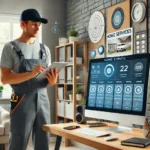What are the Common Challenges Faced During Custom App Development In Manufacturing Industry
Developing a Custom Manufacturing App? Be Prepared for These Challenges.
The days of purely mechanical factories have come and gone, and the digital manufacturing era is well underway. Modern production lines rely on automated data collection, interconnected shop floors, and “smart” machines capable of self-inspection.
Some factory owners choose to connect all these advancements through custom app development. This allows manufacturing groups to build novel technologies around proprietary processes. However, developing software for complex industrial workflows isn’t easy. Even experienced developers may find creating tools that meet real-world production needs challenging.
Misunderstandings Between Tech Teams and Factory Workers
Software development and manufacturing are two distinct industries with vastly different knowledge bases. This disconnect creates considerable potential for misunderstandings when developers and factory owners come together. Before developers can build a custom app or software tool for the factory, they must understand what occurs on the shop floor and throughout the value chain.
Without a deep understanding of industrial workflows, developers risk creating programs that miss the mark. Usability is another concern. Overly technical apps that lack intuitive design or disrupt existing routines can be off-putting to busy factory workers, slowing them down and reducing productivity. Overcoming this challenge requires strong stakeholder communication.
Real-Time Data Processing and Edge Computing
Real-time data is vital for modern manufacturing. For example, live information about machinery temperatures or pressure levels can prevent break-downs that would disrupt factory operations. Developing software to handle the massive data pulled through machine sensors can be challenging, especially with limited resources.
The goal is to produce a program that can analyze complex data rapidly and trigger near-instant reactions on the shop floor. One solution is edge computing, which places data processing closer to the devices rather than in the cloud. This speeds up response times but adds another level of complexity to the software development project.
Cyber Security for IoT Devices
The more end devices we introduce into a network, the greater the cyber security risk. Factories that use the Internet of Things (IoT) to monitor machinery performance and energy usage will need more protection against malware and ransomware. This need increases with edge computing, introducing localized servers that can become network weak points.
The data from these IoT devices will flow through your custom business app. As such, development must include rigorous security testing. This helps developers identify vulnerabilities in the program before deployment and build adequate encryption and access control defenses. Security testing requires a specialized skill set and can significantly raise the software project’s cost.
Transitioning Away From Legacy Systems
Much of the manufacturing industry relies extensively on legacy software that offers little integration with modern technologies. For instance, legacy SCADA systems were designed to work in isolation, making it difficult to connect them to the cloud. Integrating established systems with new platforms can complicate custom app development for manufacturing.
This situation often calls for the development of middleware – intermediate software that connects two programs – or custom APIs. Even if this is done seamlessly, manufacturers may still face resistance from floor workers who prefer the comfort of old, yet familiar, software.
Contingency Planning for System Downtime
According to Sensye’s True Cost of Downtime report, the average large plant loses 27 hours a month to unplanned downtime. This is more than a full day of productivity. Such downtime can cost manufacturers up to $150,000 an hour.
The impact of downtime in manufacturing is undeniable, yet many developers do not fully comprehend its repercussions. This may lead to software that fails to provide fallbacks for server outages or network problems, rendering them virtually useless when disaster strikes. Planning for downtime requires additional software infrastructure that can make development more complex.
Strict Regulatory Compliance
Software developers must work with compliance officers to familiarize themselves with all the relevant regulations for their sector. In the case of manufacturing, that regulation list is very long. As one of the most regulated industries in the world, manufacturing is fraught with restrictions and requirements that inevitably shape how manufacturing software is designed.
Integrating occupational safety, fair labor standards, environmental protection, and data privacy into a custom app or software platform is no small feat. This becomes even more challenging when building tech stacks for companies that manufacture highly regulated products like chemicals, children’s products, or pharmaceuticals.
The Solution? A Software Developer Who Specializes in Manufacturing
Custom app development in the manufacturing sector requires an in-depth understanding of the industrial economy. Zelifcam Software is a digital partner of choice for manufacturing plants in the U.S. Book a discovery call to get custom business app development for your factory.





